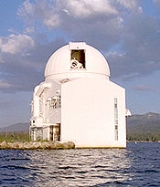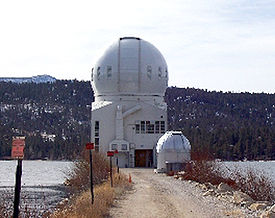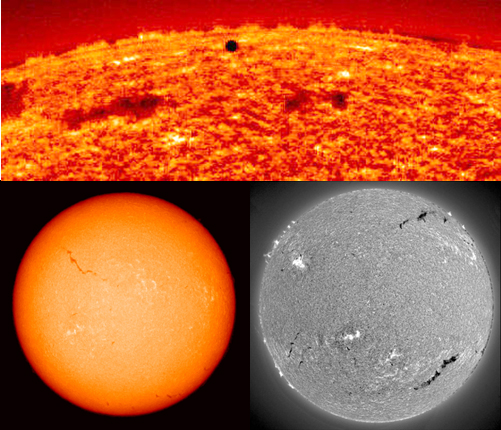
Big Bear Solar Observatory
Encyclopedia
The Big Bear Solar Observatory (BBSO) is an astronomical telescopic observatory
with main interests in studying the physics of the Sun
. The instruments and telescopes of the observatory are designed and employed specifically for studying the activities and phenomena of our solar system's star. The observatory is also participating in an experiment in helioseismology
with the use of a GONG telescope from the Global Oscillation Network Group. The BBSO has been operated by the New Jersey Institute of Technology
since 1997.
The BBSO is located on the north shore of Big Bear Lake
in the San Bernardino Mountains
, San Bernardino County, California
. A causeway has been built to put the observatory building into the open waters of the lake.
in 1969 under the direction of professor Harold Zirin
. The location of Big Bear was optimal for its clarity of sky. The lake surface is about 6,750 feet above sea level
. Its position out on the peninsula provides a cooling effect on the atmosphere surrounding the building and eliminates ground heat radiation waves that normally would cause heat wave aberrations. Management of the observatory was transferred to the New Jersey Institute of Technology in 1997. Funding comes from NASA
, the National Science Foundation
, the US Air Force and other agencies.
 The observatory has been operating with a 65 cm vacuum reflector telescope, a 25 cm vacuum refractor, and a 20 cm full disc telescope. The 65 and 25 cm telescopes study sunspots while the 20 cm full disc telescope tracks the full orbit of the Sun from sunrise to sunset.
The observatory has been operating with a 65 cm vacuum reflector telescope, a 25 cm vacuum refractor, and a 20 cm full disc telescope. The 65 and 25 cm telescopes study sunspots while the 20 cm full disc telescope tracks the full orbit of the Sun from sunrise to sunset.
By late spring 2007 it was planned that the 65 cm, 25 cm and 20 cm scopes be replaced by a new 1.6 meter, open frame, clear aperture telescope. The 20 cm telescope will be replaced by a similar telescope in an additional small dome. The old dome has been replaced with a larger, more spherical, ventilated dome to contain the new 1.6 meter telescope from DFM Engineering
. It was under active construction in 2008, and saw first light of the sun in January 2009.

Observatory
An observatory is a location used for observing terrestrial or celestial events. Astronomy, climatology/meteorology, geology, oceanography and volcanology are examples of disciplines for which observatories have been constructed...
with main interests in studying the physics of the Sun
Sun
The Sun is the star at the center of the Solar System. It is almost perfectly spherical and consists of hot plasma interwoven with magnetic fields...
. The instruments and telescopes of the observatory are designed and employed specifically for studying the activities and phenomena of our solar system's star. The observatory is also participating in an experiment in helioseismology
Helioseismology
Helioseismology is the study of the propagation of wave oscillations, particularly acoustic pressure waves, in the Sun. Unlike seismic waves on Earth, solar waves have practically no shear component . Solar pressure waves are believed to be generated by the turbulence in the convection zone near...
with the use of a GONG telescope from the Global Oscillation Network Group. The BBSO has been operated by the New Jersey Institute of Technology
New Jersey Institute of Technology
New Jersey Institute of Technology is a public research university in Newark, New Jersey. It is often also referred to as Newark College of Engineering ....
since 1997.
The BBSO is located on the north shore of Big Bear Lake
Big Bear Lake
Big Bear Lake is a reservoir in the San Bernardino Mountains, in San Bernardino County, California, United States. At a surface elevation of , it has an east-west length of approximately 7 miles and is approximately 2.5 miles at its widest measurement, though the lake's width mostly averages a...
in the San Bernardino Mountains
San Bernardino Mountains
The San Bernardino Mountains are a short transverse mountain range north and east of San Bernardino in Southern California in the United States. The mountains run for approximately 60 miles east-west on the southern edge of the Mojave Desert in southwestern San Bernardino County, north of the...
, San Bernardino County, California
California
California is a state located on the West Coast of the United States. It is by far the most populous U.S. state, and the third-largest by land area...
. A causeway has been built to put the observatory building into the open waters of the lake.
About the observatory
The observatory was built by the California Institute of TechnologyCalifornia Institute of Technology
The California Institute of Technology is a private research university located in Pasadena, California, United States. Caltech has six academic divisions with strong emphases on science and engineering...
in 1969 under the direction of professor Harold Zirin
Harold Zirin
Harold "Hal" Zirin is a retired American solar astronomer.-Life:While born in Boston, Harold Zirin was raised in the Bronx, New York and Bridgeport, Connecticut. Harold Zirin received a Pepsi-Cola Scholarship to Harvard University at age 16 and received his bachelors degree in 1950...
. The location of Big Bear was optimal for its clarity of sky. The lake surface is about 6,750 feet above sea level
Sea level
Mean sea level is a measure of the average height of the ocean's surface ; used as a standard in reckoning land elevation...
. Its position out on the peninsula provides a cooling effect on the atmosphere surrounding the building and eliminates ground heat radiation waves that normally would cause heat wave aberrations. Management of the observatory was transferred to the New Jersey Institute of Technology in 1997. Funding comes from NASA
NASA
The National Aeronautics and Space Administration is the agency of the United States government that is responsible for the nation's civilian space program and for aeronautics and aerospace research...
, the National Science Foundation
National Science Foundation
The National Science Foundation is a United States government agency that supports fundamental research and education in all the non-medical fields of science and engineering. Its medical counterpart is the National Institutes of Health...
, the US Air Force and other agencies.
Instruments

By late spring 2007 it was planned that the 65 cm, 25 cm and 20 cm scopes be replaced by a new 1.6 meter, open frame, clear aperture telescope. The 20 cm telescope will be replaced by a similar telescope in an additional small dome. The old dome has been replaced with a larger, more spherical, ventilated dome to contain the new 1.6 meter telescope from DFM Engineering
DFM Engineering
DFM Engineering is an American telescope and optics manufacturer. DFM Engineering was founded in 1979 by Dr. Frank Melsheimer. DFM makes medium size Cassegrain telescopes and their associated systems including telescope optics, control systems, and mounts. A range of pre-designed telescopes are...
. It was under active construction in 2008, and saw first light of the sun in January 2009.
Tours
Since the construction of the New Solar Telescope began, no public tours have been scheduled. For more information contact the observatory at:-
- Big Bear Solar Observatory
- 40836 North Shore Lane
- Big Bear City, CA 92314
- Phone: (909) 866-5791
Solar images

External links
- Big Bear Solar Observatory Clear Sky Clock Forecast of observing conditions.

